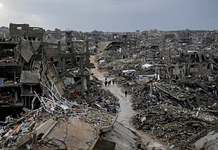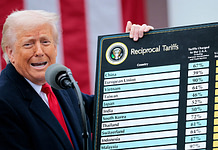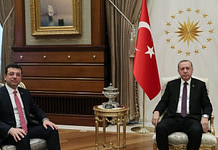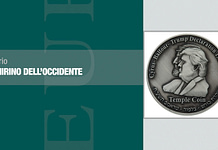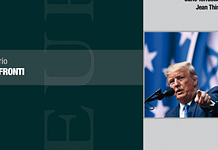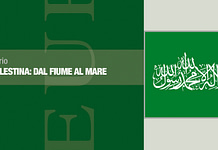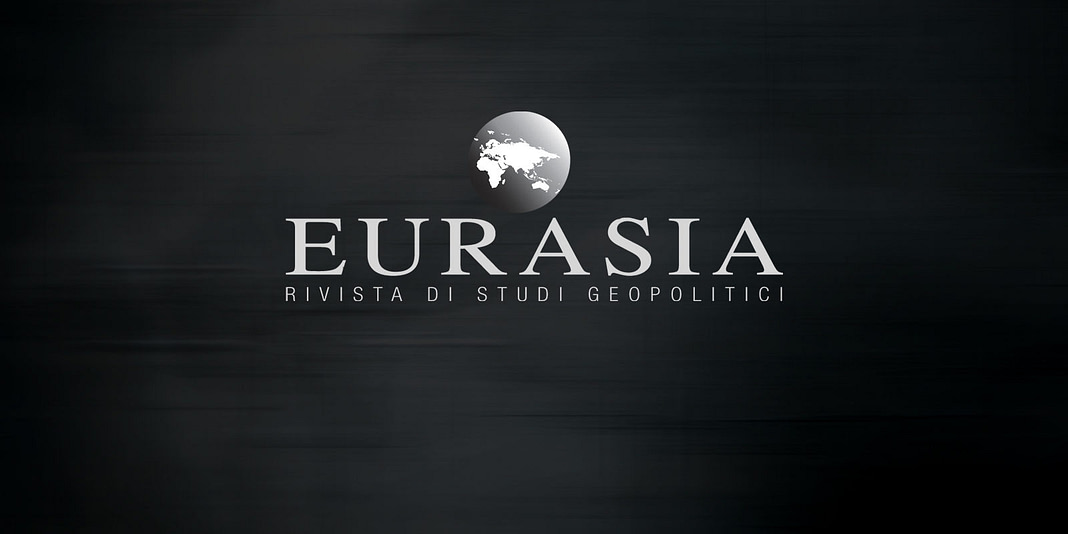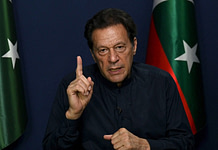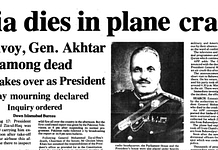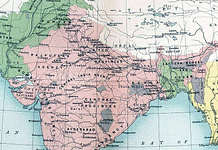Quella che segue è la relazione prodotta da Tiberio Graziani, direttore di “Eurasia”, per il Forum Internazionale “La produzione di droga in Afghanistan: una sfida per la comunità internazionale” (Mosca, 9-10 giugno 2010), cui ha preso parte su invito degli organizzatori.
The following analysis offers a geopolitical perspective as a key for understanding the relationship between U.S. global strategy and the presence of North American forces in Afghanistan. U.S. penetration in the Eurasian landmass is examined with special emphasis on the Central Asian region, considered as the underbelly of Eurasia in the context of U.S. geopolitical interests. To identify the real players in the Afghan theatre, certain benchmarks generally used in studies relating to geopolitics and international relations have also been applied here. The main characteristics of potential candidates qualified to deal with the Afghan drug question are reviewed. Among these a particular role devolves on Iran, Russia ad China. In any event, due to the interrelation between U.S. strategy in Eurasia and the stabilization of Afghanistan, the latter can be fully achieved only in the framework of a Eurasian integration process.

In order to address properly, without any ideological prejudice, but with intellectual honesty, the question about drug production in Afghanistan and the related international problems, it is necessary and useful to define (even if in broad terms) the geopolitical framework and to further clarify certain concepts, usually assumed to be understood and widely shared.
The geopolitical framework
Considering today’s main global actors, namely the U.S., Russia, China and India, their geographic location in the two distinct areas of America and Eurasia and, above all, their relations in terms of power and world geo-strategy, Afghanistan constitutes, together with the Caucasus and the Central Asian Republics, a large area (fig. 1), whose destabilization offers an advantage to the U.S., i.e. to the only geopolitical player external to the Eurasian context. In particular, the destabilization of this large region affords the U.S. at least three geopolitical and geo-strategic opportunities: a) its progressive penetration in the Eurasian landmass; b) the containment of Russia; c) the creation of a vulnus in the Eurasian landmass.
U.S. penetration in Eurasia — U.S. encirclement of Eurasia
As stated by Henry Kissinger, the bi-oceanic nation of the U.S. is an island outside of the Eurasian Continent. From the geopolitical point of view, this particular location has determined the main vectors of U.S. expansion throughout the Planet. The first was the control of the entire Western hemisphere (North and South America), the second one has been the race for hegemony over the Euroafroasian landmass, that is to say the Eastern hemisphere.
With regard to the process of U.S. penetration into the Eurasian landmass, starting from the European peninsula, it is worth remembering that it began, in the course of WWI, with Washington’s interference in the internal quarrels between the European Nations and the Empires. The penetration continued during WWII. In April 1945, the so-called “Liberators” occupied the Western part of Europe up to East Berlin. Starting from this date, Washington and the Pentagon have regarded Europe, i.e. the Western side of Eurasia, like a U.S. bridgehead linking it to the Eurasian landmass. The U.S. imposed a similar role to the other occupied nation, Japan, representing the Eastern insular arc of Eurasia. From an Eurasian point of view, the North American “pincer” was the true outcome of WWII.
With the creation of certain military “tools” like NATO (North Atlantic Treaty Organization) (1949), the security treaty among Australia, New Zealand, United States (ANZUS, 1951), the Baghdad Pact, that afterwards evolved into CENTO Pact (Central Treaty Organisation, 1959), the Manila Pact – SEATO (South East Asia Treaty Organization, 1954), the military encirclement of the whole Eurasian landmass was accomplished in less than one decade.
The third step of the U.S. long march towards the heart of Eurasia, starting from its Western side, was carried out in 1956, during the Suez crisis, with the progressive removal of France and, under certain aspects, also of Great Britain as geopolitical actors in the Mediterranean Sea. On account of the “special relationship” between Tel-Aviv and Washington, the U.S. became an important player in the Near Eastern region in a time lapse shorter than 10 years. Following its new role in the Near and Middle East, the U.S. was able either to consolidate its hegemonic leadership within the Western system or to consider the Mediterranean Sea as the starting point of the long road that would eventually enable U.S. troops to reach the Central Asian region. U.S. infiltration into the vast Eurasian zone occurred also in other geopolitical sectors, particularly the South-Eastern one (Korea, 1950-1953; Vietnam, 1960-1975).
In accordance with its strategy aimed at dominating the Eastern hemisphere, Washington worked also at the diplomatic level, focusing its attention on Beijing. With the creation of the axis Washington – Beijing, conceived in tandem by Kissinger and Nixon (1971-1972), the U.S. contributed towards exacerbating the fracture inside the so-called socialist field, constituted by China and URSS and, thus, to block any potential “welding” between the two “lungs” of Eurasia, China and Russia.
During the seventies, two main geopolitical axes faced each other within the Eurasian landmass: the Washington-Islamabad-Beijing axis and the Moscow-New Delhi one.
1979, the year of destabilization and its legacy for today’s Afghanistan
Among the many events affecting international relations whick took place in 1979, two are of pivotal importance for their role in upsetting the geopolitical equation, based at the time on the equilibrium between the United States and the URSS.
We are speaking of the Islamic revolution in Iran and of the Russian military involvement in Afghanistan.
Following the takeover of Iran by the Ayatollah Khomeyni, one of the essential pillars of the western geopolitical architecture, with the U.S. as the leader, was destroyed.
The Pahlavi monarchy could easily be used as a pawn in the fight between the U.S. and the URSS, and when it disappeared both Washington and the Pentagon were forced to envision a new role for the U.S. on the world scene. A new Iran, now autonomous and out of control, introduced a variation in the regional geopolitical chessboard, possibly able to induce a profound crisis within the “stable” bipolar system. Moreover, the new Iran, established as a regional power against the US and Israel, possessed such characteristics (especially its geographic extent and centrality, and its political-religious homogeneity) as to compete for the hegemony over at least part of the Middle-East, in open contrast to similar interests on the part of Ankara and Tel-Aviv, faithful allies of Washington, Islamabad, Baghdad and Riyadh. For such reasons, Washington strategists, in accordance with their bicentennial “geopolitics of chaos”, persuaded Saddam Hussein to start a war against Iran. The destabilization of the whole area allowed Washington and Western countries enough time to plan a long-term strategy and in the meantime to wear down the Soviet bear.
In an interview released to French weekly Le Nouvel Observateur [1], Zbigniew Brzezinski, President Jimmy Carter’s national security adviser, revealed that the CIA had secretly operated in Afghanistan to undermine the regime in Kabul since July 1979, that is to say, five months before the Soviet invasion. Indeed, it was on July 3, 1979, that President Carter signed the first directive to provide secret aid to the opponents of the pro-Soviet regime in Kabul. That very day the Polish-born U.S. strategist wrote a note to President Carter in which he explained that this aid was going to induce a Soviet military intervention. And this is precisely what happened the following month of December. In the same interview, Brzezinski recalls that, when the Soviets invaded Afghanistan, he wrote another note to President Carter in which he expressed his opinion that at that point the USA had the opportunity of giving to the USSR its Vietnam War.
In Brezinski’s opinion, this intervention was unsustainable for Moscow and in time would have led to the collapse of the Soviet Empire. In fact, the drawn out Soviet war in support of the communist regime in Kabul further contributed to the weakening of the Soviet Union, already engaged in a severe internal crisis, encompassing both political- bureaucratic and socio-economic aspects. As we now well know, the Soviet withdrawal from the Afghan theatre left behind an exhausted country, whose political situation, economy and geo-strategic assets were extremely weak. Indeed, after less than 10 years from the Teheran revolution, the entire region had been completely destabilized exclusively to the advantage of the western system. The parallel and unrestrained decline of the Soviet Union, accelerated by the Afghan adventure, and, afterwards in the nineties, by the dismemberment of the Yugoslav Federation (a sort of buffer state between the Western and Soviet blocks) changed the balance of power to favour U.S. expansionism in the Eurasian region.
After the bipolar system, a new geopolitical era began, that of the “unipolar moment”, in which the USA was the “hyperpuissance” (according to the definition of the French minister Hubert Védrine).
However, the new unipolar system was going to be short lived and indeed it ended at the beginning of the XXI century, when Russia re-emerged as a strategic challenger in global affairs and, at the same time, China and India, the two Asian giants, emerged as economic and strategic powers. On the global level, we have to consider also the growing weight of some countries of Indigenous Latin America, such as Brazil, Venezuela. The very important relations of these countries with China, Russia and Iran seem to acquire a strategic value and prefigure a new multipolar system, whose two main pillars could be constituted by Eurasia and Indigenous Latin America.
Afghanistan – due to its geographical characteristics, to its location in respect of the Soviet State (whose neighbouring nations Turkmenistan, Uzbekistan and Tajikistan were, at that time, Soviet Republics), and to the wide variety of ethnic groups forming its population, different either in culture or in religion – represented for Washington an important portion of the so-called “arc of crisis”, namely that geographical region linking the southern boundaries of the USSR and the Arabian Sea. The Afghanistan trap for the URSS was therefore chosen for evident geopolitical and geo-strategic reasons.
From the geopolitical point of view, Afghanistan is clearly representative of a crisis zone, being from time immemorial a stage for the conflicts among Great Powers.
The area is now “ruled” by the governmental entity established by U.S. forces and named Islamic Republic of Afghanistan, but traditionally the Pashtun tribes have dominated over the other ethnic groups (Tajiks, Hazaras, Uzbeks, Turkmens, Balochs). Its history was intertwined with broader events involving the interaction and the prolonged fighting among the three neighbouring great geopolitical entities: the Moghul Empire, the Uzbek Khanate and the Persian Empire. In the 18th and 19th centuries, when the country was under the rule of the Kingdom of Afghanistan, the area became strategic in the rivalry and conflict between the British Empire and the Russian Empire for supremacy in Central Asia, termed “The Great Game”. The Russian land empire, in its efforts to secure access to the Indian Ocean, to India and to China, collided with the interests of the British maritime empire, that, for its part, sought to expand into the Eurasian landmass, using India as a staging post, towards the East, to Burma, China, Tibet and the basin of the Yangtze river, and towards the West, to present-day Pakistan, Afghanistan and Iran, as far as the Caucasus, the Black Sea, to Mesopotamia and the Persian Gulf. Towards the end of the 20th century, in the framework of the bipolar system, Afghanistan became the battlefield where, once again, a maritime Power, the USA, confronted a land Power, the URSS.
The actors that confronted each other on this battlefield were basically: URSS troops, Afghan tribes and the so-called mujahideen, the latter were supported by US, Pakistan and Saudi Arabia.
After the withdrawal of the Soviet troops from the Afghan chessboard, the Taliban movement took on an increasingly important role in the region, on the basis of at least three main factors: a) ambiguous relations with some components of the Pakistani secret services; b) ambiguous relations with the U.S. (a sort of “legacy” stemming from the previous contacts between the U.S. and some components of the “mujahideen” movement which occurred during the Soviet – Afghan war); c) wahabism as an ideological-religious platform directly instrumental for the interests of Saudi Arabia in its projection towards certain zones as Bosnia, the Middle East area and the Caucasus (namely Chechnya and Dagestan).
The three elements mentioned above allowed the Taliban movement, on the one hand, to insert and root itself in the Afghan zone, gaining increasing importance at the military (with the creation and consolidation of the so-called sanctuaries) and economic (namely control of the drug traffic) levels, while impeding it, on the other hand, from becoming an autonomous organization. Actually, because of its infiltration by the U.S., Pakistan and Saudi Arabia, the Taliban movement has to be considered as local organization directed by external players. Such considerations enable us to better understand and explain the choice made by Obama and Karzai to open a dialogue with the Talibans, and even to include some of them in local governments. Moreover, the apparent contradictory behaviour of the U.S. (and Karzai) in Afghanistan, could be explained in light of the theory and praxis according to which, entrusting the enemy with institutional responsibilities aims to weaken it, and follows the classic rule of U.S. geopolitical praxis to maintain in a state of crisis a region considered strategic.
As we well know now, the drug production in Afghanistan has gone up more or less 40 times since the country’s occupation by NATO.
If we examine the measures adopted so far by U.S. forces aimed at containing and overcoming the drug trafficking issue in the broader context of U.S. geopolitical policies, we can observe that U.S. and NATO forces are apparently “wasting” their time: drug production and distribution in the southern part of the country are still going on. As we well know, a large-scale drug production is impossible in this area, because of the ongoing fighting. Hence, U.S. and NATO forces are focusing their strategic interest in the northern part of the country. Here, they have built roads and bridges linking Afghanistan to Tajikistan (the road to Russia via Uzbekistan), Kyrgyzstan and Azerbaijan (see A. Barentsev, Afghan Heroine flow channelled to Russia, FONDSK). This modus operandi unveils the real intentions of the Pentagon and Washington: opening a road towards Russia, starting from Afghanistan and the Central Asian republics. In fact, NATO and other western forces are not waging a genuine fight against drug production and trafficking.
In this context, the reported US/NATO fight against drug production and trafficking in Afghanistan seems to belong to the realm of Western rhetoric rather than being a concrete fact (Fig. 2).

Similarly, the fight against the Taliban movement seems to be clearly subordinated to (and thus dependent on) the general strategy of the U.S. in the Eurasian landmass. Nowadays, this strategy consists in the setting up of military garrisons by the U.S. and its Western allies along the strip that, starting from Morocco, crosses the Mediterranean Sea and arrives as far as the Central Asian republics. The principal goals of these garrisons are: a) the separation of Europe from North Africa; b) the control of north Africa and the Near East (particularly the zone constituted by Turkey, Syria and Iran – using the Camp Bondsteel base, located in Kosovo); b) the containment of Russia, and, under certain aspects, of China too; c) an attempt at cutting the Eurasian landmass in two parts; d) the enlargement of the “arc of crisis” in the Central Asian area [Brzezinski defines this area the “Balkans of Eurasia” (the definition of President Carter’s former adviser rings more like a strategic plan than an objective description of the area)].
Creating a geopolitical chasm in Central Asia, i.e. a vulnus in the Eurasia landmass, could lead to hostility and enmity among the main players in Asia, Russia, India and China (fig. 3). The only beneficiary of this game would thus be the United States.

- The huge arc of crisis.
In addition to the attempt “to knife” Eurasia along the illustrated path (from the Mediterranean Sea up to the Central Asia), we observe that the U.S. can rely on (since 2008) AFRICOM and, of course, the related cooperative security locations in Africa: a useful military “device” which is also pointed in the direction of the Middle East and part of Central Asia (fig. 4).
In order to understand the importance of the Central Asian zone for the strategy of the U.S. in terms of extending its hegemony over the Eurasian landmass, it is enough to glance at the following picture (fig. 5), illustrating the U.S. Commanders’ areas of responsibilities. The picture is representative of what we can call – paraphrasing the expression “the white man’s burden” formulated by the bard of British imperialism, Rudyard Kipling, 1899 – the “US’ burden”.
General remarks on “accepted and shared“ concepts
With a view to reaching a broader understanding of the complex dynamics presently at work on a global level, it is useful to criticize a number of general concepts which we consider to be widely accepted and shared. As we know, in the framework of a geopolitical analysis, the correct use of terms and concepts is at least as important as those related to the description of the reality through maps and diagrams. For instance, the so-called “globalization” is only a euphemistic expression for the economic expansionism of the U.S. and its capitalistic western allies (see Jacques Sapir, Le nouveau XXI siécle, Paris, 2008, p. 63-64). Even the rhetorical call for the defense of supposed “human rights”, or similar democratic values, put out by some think-thanks, governments or simple civilian activists, highlights the colonialist bias of the U.S. on the mass media and culture, without any consideration for other ways of life, like those expressed by non-western civilisations, i.e. more than three quarters of the world population. Among these concepts, we have to consider the most important one from the geopolitical (and international relations) point of view, that is the so-called International Community. The expression “International Community” does not mean anything in geopolitical terms. Actually, the International Community is not a real entity; its related concept sounds, simultaneously, like an aspiration of some utopian activists and a specific falsification of history.
In the real world as we know it – made up of states, nations, people, international organisations [generally based on (hegemonic) “alliances”] and, of course the relations among these entities – speaking in generic terms of an International Community actually means to mis-describe the real powers currently acting at global and local scales.
Considering now the focus of the International Forum on drug production in Afghanistan (Moscow, June 9-10 2010), aimed at finding “shared solutions” for the Afghan drug question in the context of the “International Community” (I.C.), as analysts, we honestly have to underline that instead of I.C. it is more pragmatic to speak of the real players involved (and that could be involved) in the Afghan zone.
The real players in the Afghan theatre
For analytical reasons is useful to aggregate the players involved in the Afghan theatre in the following three categories: external players; local players; players who could potentially become involved in the Afghan context. Afterwards we can easily define some conditions in order to delineate the characters of those partners who would be in a position to stabilize – effectively – the entire geopolitical area.
![]() External players: US and NATO-ISAF (except Turkey) forces are to be considered external players because they are totally foreign to the specific geopolitical area, even if conceived in a broad sense;
External players: US and NATO-ISAF (except Turkey) forces are to be considered external players because they are totally foreign to the specific geopolitical area, even if conceived in a broad sense;
![]() Local players: among the local players we can enumerate the bordering countries (Iran, Turkmenistan, Uzbekistan, Tajikistan, China, Pakistan), the tribes, the insurgent forces, the Taliban and the “governmental” entity led by Karzai.
Local players: among the local players we can enumerate the bordering countries (Iran, Turkmenistan, Uzbekistan, Tajikistan, China, Pakistan), the tribes, the insurgent forces, the Taliban and the “governmental” entity led by Karzai.
![]() Regarding the players belonging to the third category as defined above, we can include the Collective Security Treaty Organisation (CSTO), the Shanghai Cooperation Organisation (SCO), i.e. the main Eurasian organisations with a large experience in managing questions related to the border control and drug trafficking of Central Asian area, and the Eurasian Economic Community (EURASEC). Moreover we have to mention also ONU, in particularly the United Nations Office on Drugs and Crime (UNODOC).
Regarding the players belonging to the third category as defined above, we can include the Collective Security Treaty Organisation (CSTO), the Shanghai Cooperation Organisation (SCO), i.e. the main Eurasian organisations with a large experience in managing questions related to the border control and drug trafficking of Central Asian area, and the Eurasian Economic Community (EURASEC). Moreover we have to mention also ONU, in particularly the United Nations Office on Drugs and Crime (UNODOC).
![]() Potential partners capable of overcoming the drug question in Afghanistan have to present at least the following characteristics: a) the knowledge of the local dynamics related to the ethnic, cultural, religious and economic aspects; b) the acknowledgement by the local population as part of the same cultural context (obviously in a broad sense); c) the will to coordinate collectively actions without any prejudice or mental reserve within a Eurasian program.
Potential partners capable of overcoming the drug question in Afghanistan have to present at least the following characteristics: a) the knowledge of the local dynamics related to the ethnic, cultural, religious and economic aspects; b) the acknowledgement by the local population as part of the same cultural context (obviously in a broad sense); c) the will to coordinate collectively actions without any prejudice or mental reserve within a Eurasian program.
The partners presenting the features synthetically described above are those included in the second and third categories. As a matter of fact, U.S. and NATO – ISAF forces are perceived by the local population as what they really are: occupying forces. Moreover, considering NATO’s role as a hegemonic alliance led by Washington and acting within the framework of the U.S. global strategy, its presence in Afghanistan should be considered a serious obstacle to the stabilization of the entire area. The Taliban and even the governmental entity, do not appear, due to the ambiguous relations that they seem to have with the occupying U.S. forces, to be hopeful partners in a collaborative effort to triumph over the drug question in Afghanistan.
The real players with the ability to stabilize the area are – without any doubt – the Afghanistan bordering countries and the Eurasian organizations. Among the bordering countries, a special role could be played by Iran. Teheran is the only country that has demonstrated it can assure the security of Afghan-Iranian border, specially for drug trafficking. Also Moscow and Beijing assume an important function in the stabilization of the area and in the fight against drug trafficking, because Russia and China, it is worth to reiterating, are the main powers of the Eurasian organizations mentioned above. A strategic axis between the two “lungs” of Eurasia, balanced by the Central Asian republics and India, could constitute the lasting solution for the stabilization of the area and hence the drug question. Only in the framework of a shared Eurasian plan aimed at stabilizing the area – conceived and implemented by Eurasian players –, would it be possible to hold a dialogue with local tribes and with those insurgent movements which are clearly not directed by external players.
Conclusions
The stabilization of the Afghan area is an essential requirement for any plan aimed to tackle the drug production and trafficking problem.
However, because of the pivotal role of Afghanistan in the Middle East and in the Central Asian regions, the strategy to stabilize the area has to be conceived in the context of the integration of the Eurasian landmass. Candidates particularly interested to halt the drug production and traffic are the Afghanistan bordering countries.
U.S. and NATO forces, because of their clear geopolitical praxis aimed at hegemonizing the Eurasian landmass, are not credible candidates.
Questo articolo è coperto da ©Copyright, per cui ne è vietata la riproduzione parziale o integrale. Per maggiori informazioni sull'informativa in relazione al diritto d'autore del sito visita Questa pagina.


